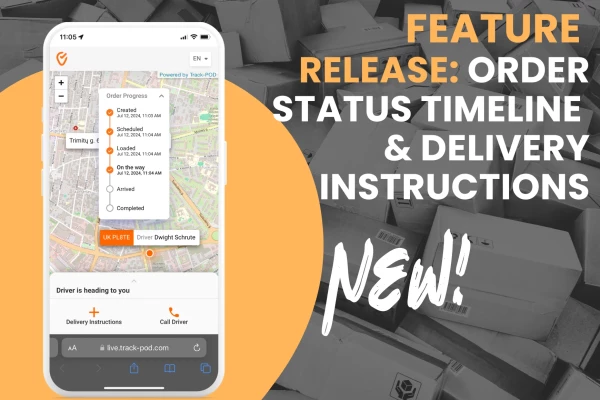Ecommerce Warehouse Management [Best Practices & Examples]

by
Burkhard Berger
June 02, 2023
The eCommerce industry has been buzzing like a beehive on a honey spree, with a remarkable surge in popularity that's got everyone talking. However, amidst this rapid growth and excitement, it’s easy to fall short of the proper eCommerce warehouse management practices.
As an eCommerce business owner, you understand the importance of delivering exceptional customer experiences and maintaining efficient operations.
But without effective warehouse management, you may find yourself facing a myriad of challenges that hinder your business growth and leave customers dissatisfied and seeking alternative options.
In this article, we're about to spill the beans on the best practices and practical techniques to help you navigate this dynamic landscape. We'll also showcase some shining examples of eCommerce businesses that have nailed the art of warehouse management.
By the end, you’ll know how to master inventory management like a pro, streamline your order fulfillment process, and implement smart technologies and tools that will help you increase your inventory turnover rates and reduce inventory shrinkage.
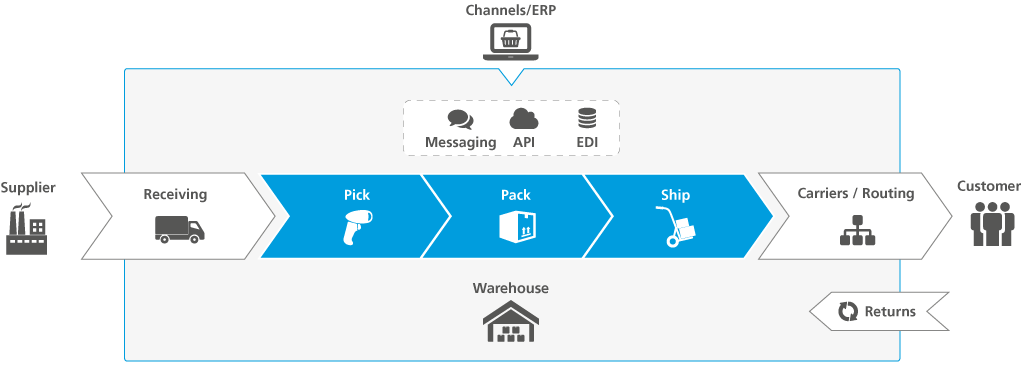
eCommerce warehouse management refers to the process of effectively organizing and controlling all the operations that take place in a warehouse. Some key processes that are involved include:
Essentially, it's like the nerve center of an online store, where all the products are stored, processed, and shipped to customers.
When managed properly, eCommerce warehouse management helps streamline operations, reduces costs, and improves customer satisfaction.
The result is a remarkable shopping experience that customers enjoy and one that sets your online business apart from the competition.
12 Warehouse management best practices & examples
A well-organized and efficient warehouse is the beating heart of operations, where inventory is managed, orders are fulfilled, and customer satisfaction is prioritized. To achieve these goals, here are the tried and tested best practices in warehouse management.
1. Establish a seamless receiving process
When it comes to receiving shipments, you want to make sure your warehouse operations kick off on the right foot. Inspect and verify each shipment promptly to ensure exact inventory and stock availability.
Double-check that the documentation, including the bill of lading (legal document), matches what's actually inside the boxes.
This attention to detail will save you headaches down the line. Once you've confirmed the accuracy of the shipment, find the perfect spot for each item in your warehouse. Efficiently allocate them to their designated locations, making it easy to find and retrieve them when needed.
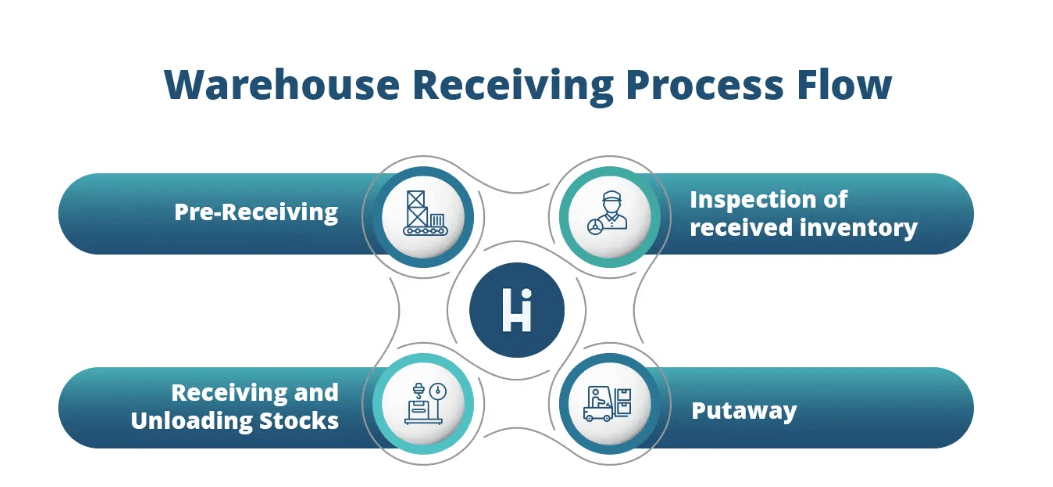
2. Master accurate inventory management
Inventory management – the key to keeping your eCommerce business running like a well-oiled machine. It's all about staying in control and avoiding those dreaded stockouts and overstocking nightmares.
You want to be the master of your inventory, knowing exactly what's in stock at all times.
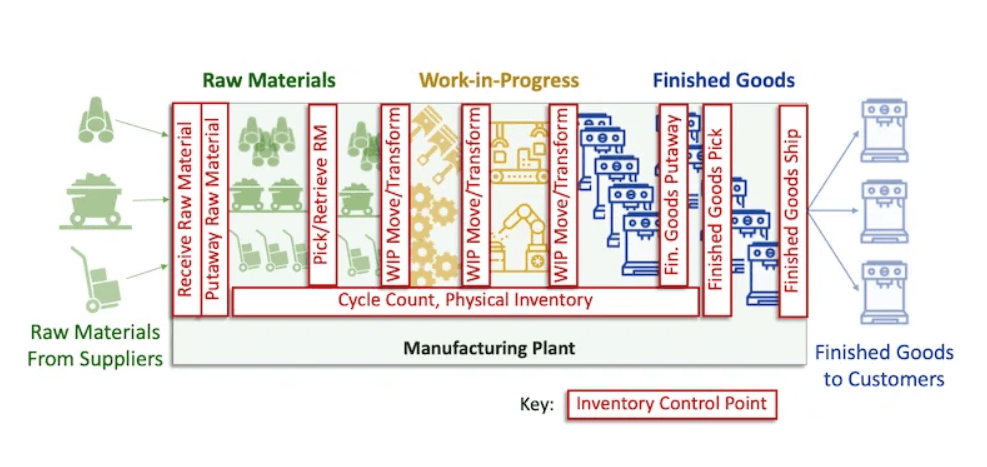
Let’s create a scenario where you run an eCommerce shoe company specializing in elderly fall prevention. As the owner, your goal is to master accurate inventory management to ensure your product availability. To do this, you need a robust inventory management system tailored to the unique needs of your shoe company.
Here's how you can excel in inventory control in the context of your eCommerce shoe business.
-
Classify your shoe inventory based on various attributes such as shoe types, sizes, colors, and specific fall prevention features for effective balance in inventory levels.
-
Leverage historical sales data and market trends to forecast demand for different shoe models.
-
Implement rigorous quality control measures to ensure the shoes you receive from suppliers meet your high standards ensuring your entire inventory is top-notch.
Essentially, this means implementing reliable tracking systems that keep you informed and up to date.
Whether it's through advanced software or good old-fashioned manual processes, accurate inventory management is your secret weapon.
It helps you fulfill orders efficiently, prevent stock shortages, excess inventory, and ensure customer satisfaction.
With meticulous tracking, forecasting, and replenishment strategies, you can position yourself as a trusted provider of high-quality shoes for elderly fall prevention, gaining customer loyalty and propelling your business to new heights.
3. Unleash the power of ABC analysis
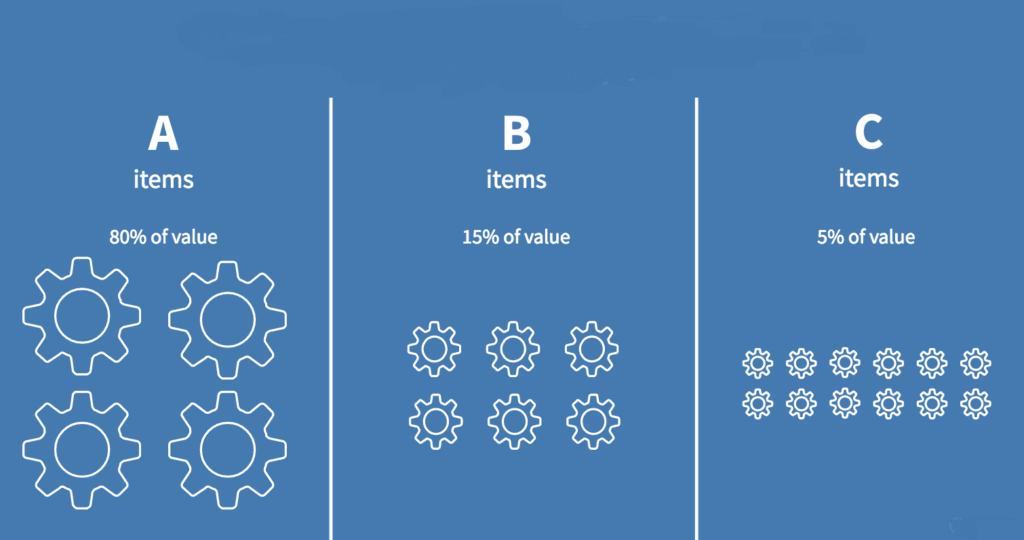
Imagine having the power to prioritize your products like a seasoned eCommerce superhero. With ABC Analysis, you can do just that. This nifty technique allows you to classify your products based on their importance and sales volume.
-
The "A" category represents high-value or fast-moving items that are the bread and butter of your business. These are the products that deserve extra attention and resources.
-
The "B" category includes items of moderate importance.
-
While the "C" category consists of lower-value or slow-moving items.
By understanding the significance of each category, you can allocate resources more effectively.
Focus your efforts on the "A" category, ensuring you have sufficient stock and efficient handling processes in place. Meanwhile, the "B" and "C" categories can receive less intense scrutiny.
With the power of ABC Analysis, you can optimize your inventory management strategy and ensure maximum productivity.
4. Give your products the spotlight they deserve
Clear and informative labels make all the difference. When each product is labeled with essential information like SKUs (Stock Keeping Units), barcodes, and descriptions, it's like a beacon guiding you through the warehouse maze.
You can locate items with ease, ensuring accurate picking and minimizing errors. Plus, informative labeling comes in handy when it's time to update your inventory records. So, take the time to label your products like a pro, but make sure the label is appropriate for the container. For example, customized shrink sleeve labels can fit on nearly any product.
5. Design a well-organized warehouse layout
It's about creating a space where everything has its designated spot, making it easy to navigate and retrieve items.
If you’re starting your own cleaning business, for instance, having adequate space is essential for storing and managing your cleaning supplies and equipment. In this case, start by dividing your warehouse space into different zones based on product categories.
For example, designate an area for cleaning chemicals, another for cleaning tools and equipment, and a separate section for disposable items like gloves and wipes.
This simple step ensures that similar items are grouped, reducing the time spent searching for specific products.
You can even take it a step further by placing frequently accessed items closer to the packing and shipping areas.
This way, you'll have those popular items within arm's reach, speeding up the fulfillment process.

6. Set the bar high for quality
In the world of eCommerce, quality is non-negotiable. That's why you should implement stringent quality control checks using work order software to ensure your customers receive top-notch products even when offering the most affordable deals.
Establish clear quality standards and conduct regular inspections to maintain the highest quality level. Perform random checks to catch any potential issues of all your offers before they reach your customers' hands.
One excellent example of a company that prioritizes quality is Going, a reputable source of affordable flights. They understand the importance of maintaining the highest level of excellence with their flight recommendations regardless of the pricing.
To follow in Going's footsteps, start by establishing clear quality standards for your own eCommerce business, even going the extra mile by providing users a guide on finding cheap flights. Clearly define what constitutes a top-notch product and ensure that your entire team understands and adheres to these standards.
By setting the bar high for quality, you not only protect your brand's reputation but also foster customer trust and loyalty.
When your customers receive products that meet or exceed their expectations, they'll keep coming back for more.
7. Keep your inventory on point
Keeping your inventory on point is vital for smooth operations and accurate order fulfillment. Regular cycle counting ensures your inventory levels are aligned with reality.
Instead of relying solely on occasional full inventory counts, which can be time-consuming and disrupt operations, incorporate regular cycle counting.
This involves counting a small portion of your inventory regularly, making it easier to identify discrepancies early on. By catching these discrepancies early, you can take timely corrective measures and maintain accurate inventory records.
Regular cycle counting also helps prevent stockouts or overstocking, ensuring you have the right products available when customers place orders.
8. Handle returns with finesse
Returns happen, but how you handle them can make all the difference in customer satisfaction. Develop a streamlined process that's focused on finesse. Establish clear policies and guidelines for returns, ensuring your customers know what to expect.
Implement efficient procedures for inspecting returned items to assess their condition and make necessary inventory adjustments.
One company that exemplifies a customer-centric returns process on its website is ShopSolarKits. They have implemented a clear and concise returns policy, providing detailed instructions for customers on how to initiate a return and what steps to follow.
This transparency helps customers feel confident in their decision to shop with ShopSolarKits, knowing that returns are handled professionally and efficiently. By following the example set by ShopSolarKits, you can create a returns process that instills confidence in your customers.
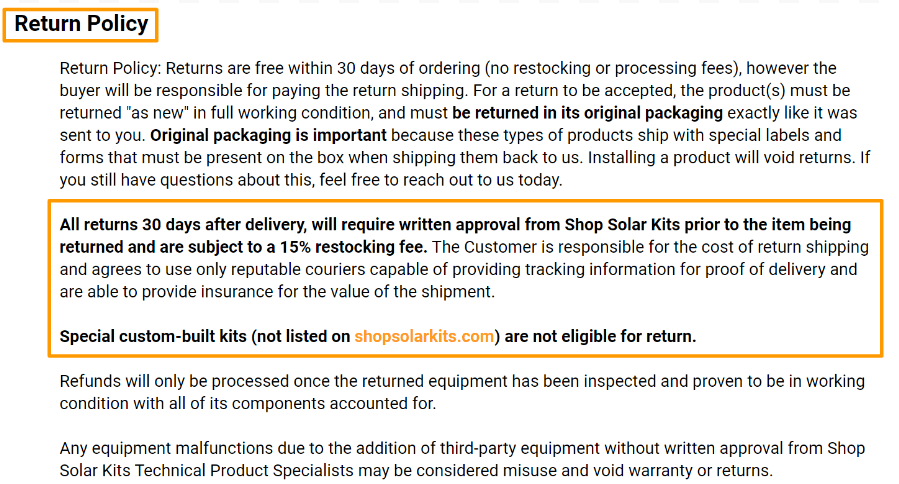
Remember, a positive return experience can leave a lasting impression on your customers and encourage repeat business.
9. Embrace automation & streamline data capture
In the age of technology, automation is the superhero sidekick that can transform your warehouse operations. Automation technologies, including custom software services, also play a vital role in meeting the technical requirements for operating an online store.
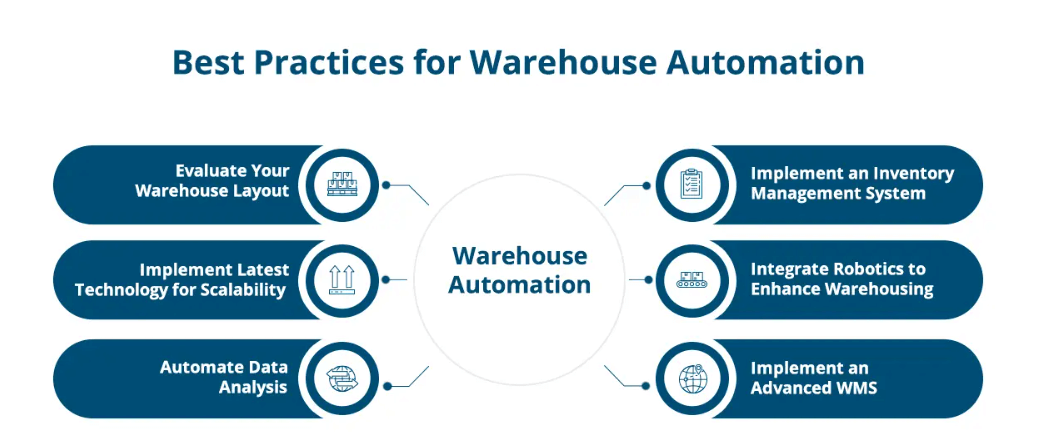
With custom software services, you can develop a warehouse management system (WMS) that is specifically designed to align with your unique business processes. This gets you full control and customization over your warehouse operations, ensuring seamless integration with your eCommerce platform and other systems.
10. Keep your customers in the loop
In the world of eCommerce, customer satisfaction is paramount. Keep your customers in the loop and provide them with an interactive experience by offering real-time order tracking and proactive notifications.
Implement a system that allows customers to track their orders from the moment they're shipped until they reach their doorstep.
An exemplary company that excels in providing real-time order tracking and proactive notifications is Anytime Baseball Supply. As a supplier of high-quality baseball gear and equipment, they understand the importance of keeping their customers engaged throughout the order process.
With their order tracking system, customers have complete visibility of their shipments, including the tracking number, estimated delivery date, and any relevant shipping notifications.
This proactive approach to communication enhances the customer experience, builds trust, and promotes repeat business.
By following in the footsteps of Anytime Baseball Supply, you can create a customer-centric approach that keeps your customers in the loop and provides them with an interactive order tracking experience.
11. Prioritize safety with protocols, equipment & training
Safety should always be a top priority in your eCommerce warehouse. Implement proper safety protocols, provide necessary safety equipment, and conduct regular training sessions to ensure a secure working environment for your team.
To ensure safety in your warehouse, start by developing protocols for operating equipment, lifting heavy objects, and handling hazardous materials.
These protocols serve as guidelines everyone should follow to minimize the risk of accidents or injuries.
For medical device manufacturers, robust design controls, for instance, are critical to ensuring the quality, safety, and effectiveness of the end product. On the other hand, maintaining strict adherence to regulatory standards and guidelines is also essential.
Medical device manufacturers should comply with various regulations, such as the Food and Drug Administration (FDA) regulations in the United States or the European Medical Device Regulation (MDR) in the European Union.
By prioritizing safety, you create a culture that values the well-being of your team members.
This not only protects them from harm but also boosts morale and productivity. When your team feels safe and supported, they can focus on their tasks with confidence and efficiency.
12. Foster strong relationships with vendors
Establish open lines of communication and build strong relationships with your suppliers. Share forecasts, sales data, and market insights to ensure timely replenishment of stock and avoid stockouts.
For example, proactively communicate with your vendors about upcoming promotions or seasonal demand fluctuations. This allows them to prepare and deliver the right quantities of products to meet your customer demands.
Work together to optimize order frequency, lead times, and minimum order quantities.
While there are common elements and best practices in warehouse management, the ideal system for your eCommerce business will address your specific pain points, streamline your processes, and enhance your overall efficiency.
3 Factors to consider when choosing the ideal warehouse management system for your eCommerce business
Choosing the proper warehouse management system for your eCommerce business is a critical decision that will have a significant impact on your operations and overall customer satisfaction.
Ideally, you want a system that seamlessly integrates into your workflows, saves the day with its efficiency, and grows alongside your business to satisfy your customer base and prevent angry, or disgruntled customers. Here are 3 factors to consider.
Ⅰ. Understand your business needs
Assess your warehouse operations and identify the pain points. Is inventory management causing inventory shrinkage and affecting your business growth? Or do you need help with warehouse shelves and effective eCommerce warehouse management?
Knowing your specific requirements will be your secret weapon. Consider the wide range of warehouses.
- Public warehouses offer shared storage space and services, while private warehouses provide exclusive use for a single company.
- Cooperative warehouses involve collaboration between multiple businesses, and government warehouses are owned and operated by the government.
- Fulfillment centers specialize in order processing and distribution, while smart warehouses incorporate advanced technologies for automation and optimization.
- Bonded warehouses store goods under customs control, and consolidated warehouses combine shipments from multiple suppliers.
Understanding your needs and priorities will help you choose the most suitable type of warehouse location for your business operations.
Ⅱ. Seek recommendations
Call upon your fellow eCommerce superheroes for advice. Connect with other business owners and industry experts around the globe like UAE, UK, or other relevant markets to gather insights and recommendations. They've battled similar challenges and can steer you toward systems that have saved the day for them.
Ⅲ. Research & explore
It's time to hit the books (or websites). Research different warehouse management systems, sales channels, read customer reviews, and compare their features. Look for systems that match your needs and offer user-friendly interfaces, scalability, flexibility, and rock-solid support.
Conclusion
Effective warehouse management is the backbone of successful eCommerce operations. By implementing the best practices we've discussed and incorporating real-life examples, you can elevate your warehouse operations to new heights of efficiency and customer satisfaction.
Remember to kickstart your operations with a seamless receiving process, ensuring the accuracy of inventory tracking from the moment goods arrive. Give your products the spotlight they deserve with informative labeling, use real-time data, and design a well-organized warehouse layout.
To further enhance your warehouse management capabilities, consider utilizing Track-POD's all-in-one delivery management software. Thousands of businesses, regardless of their size, rely on Track-POD to ensure seamless deliveries in full and on time, every time.
About The Author
Burkhard Berger
Burkhard Berger is the founder of Novum™. He helps innovative B2B companies implement revenue-driven SEO strategies to scale their organic traffic to 1,000,000+ visitors per month.










